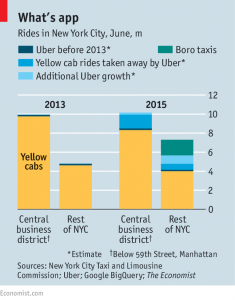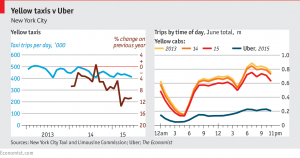Uber might be convenient, and it’s growth is promising – but it’s been hailed as a bad sign for taxi cabs, especially the massive taxi market in NYC. I used Uber in Boston on the regular, and there’s both a strong taxi cab and Uber presence there – but it doesn’t come close to NYC in regards to reliance on taxi cabs. There’s been tensions and debates this past year regarding Uber and taxis in the Big Apple this year, as they share the same (very small and highly profitable) space. About a year ago, taxi medallions (which allow taxi drivers or companies with fleets of taxis to operate) were selling for over $1 million. Now these medallions are valued at around $690,000.
So – is Uber dominating the transportation market in NYC, or is it just a sign of the times? Since Uber is still a young company, there hasn’t been much data regarding revenue and growth to back up the claims made by taxi drivers and city officials (until Uber’s growth data was leaked about a month ago). Is Uber a competitive substitute? Or a complement to NYC’s transportation options?
Current data has shown it’s more of a complement, especially when you consider location. One of the main focuses when looking at Uber’s impact was how many rides were taken from taxis in NYC’s central business district (CBD), NYC’s busiest area for yellow cabs. In the past two years, Uber has “taken” a little over 20% of rides from the yellow cabs. In New York’s busiest district, yellow cabs still dominate. However, Uber and NYC’s new green “Boro” taxis make up a bit less than half of all rides taken in the rest of NYC. Uber’s flexibility seems to have won out when residents of the outer city or less busy areas need a ride. While this may look good for the yellow cabs, Uber’s growth is massive and could impact rides in the CBD down the road.
If Uber was a true substitute, we would probably see a much larger portion of rides “taken” from yellow cabs. Based on the bar graph, there is more general Uber growth in the rest of NYC than there were Uber rides “taken” from taxis. And the line graph shows that Uber is not even remotely competitive with cabs in trips taken at any time of the day, despite a drastic drop in taxi rides this past year. It looks like the addition of a new and convenient transportation option mostly increased the amount of rides taken in NYC, rather than caused people to consciously avoid cabs and book a Uber ride instead. These findings also haven’t taken into consideration any changing trends in subway, bus, car or bicycle usage. Is Uber taking rides away from subways?
As long as cab fares remain competitive and there are still fleets on the streets, yellow cabs seem to be safe in NYC (for now).



Hi Lorraine,
Great post. I was just wondering if you knew if there was any use of Uber by taxi drivers? Do they use Uber to find fares in addition to the calls they get?
Hi Ryan,
Great question! Any info I could find on that was pretty qualitative and anectdotal – but it would be interesting to see data on how uber and taxi drivers interact and use each other’s systems (assuming they do).
Thanks Lorraine 🙂
Great article. I know I never use taxis but have started using uber because I like the convenience and feel like the drivers are safer (slower).